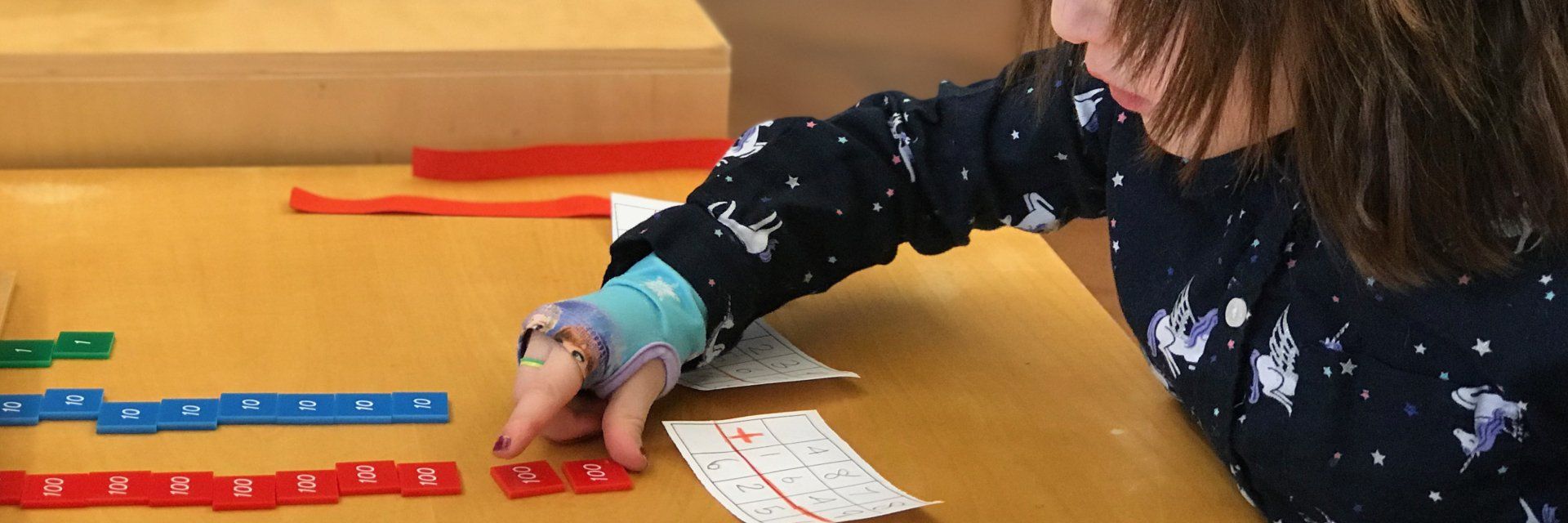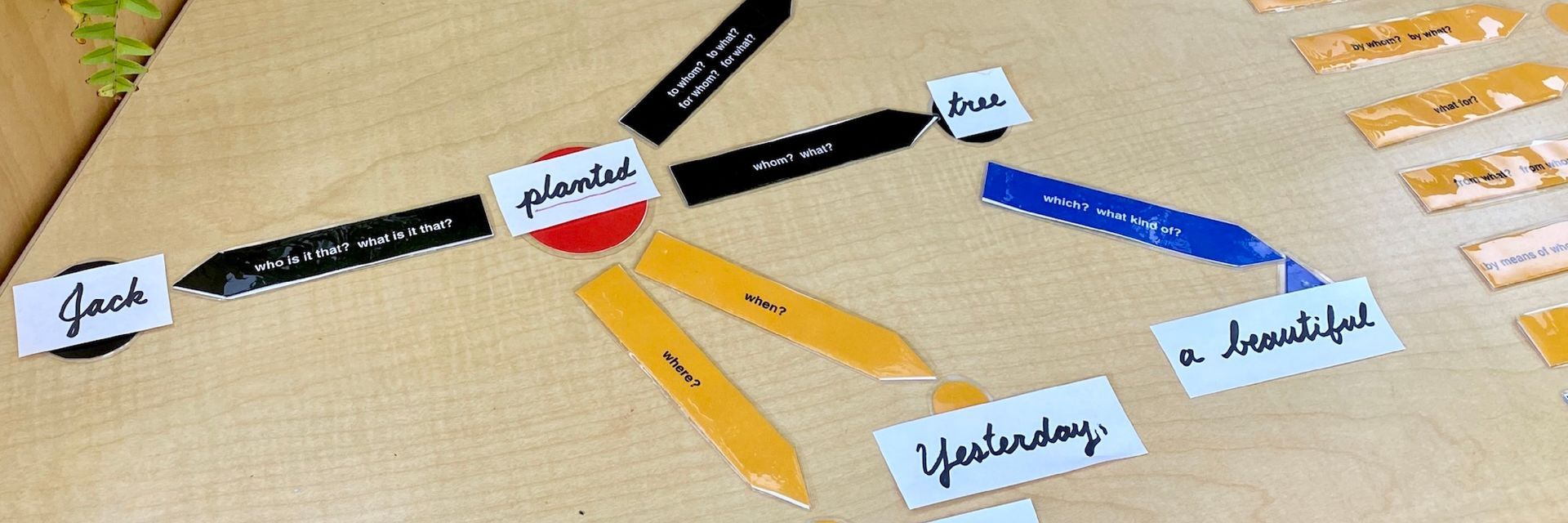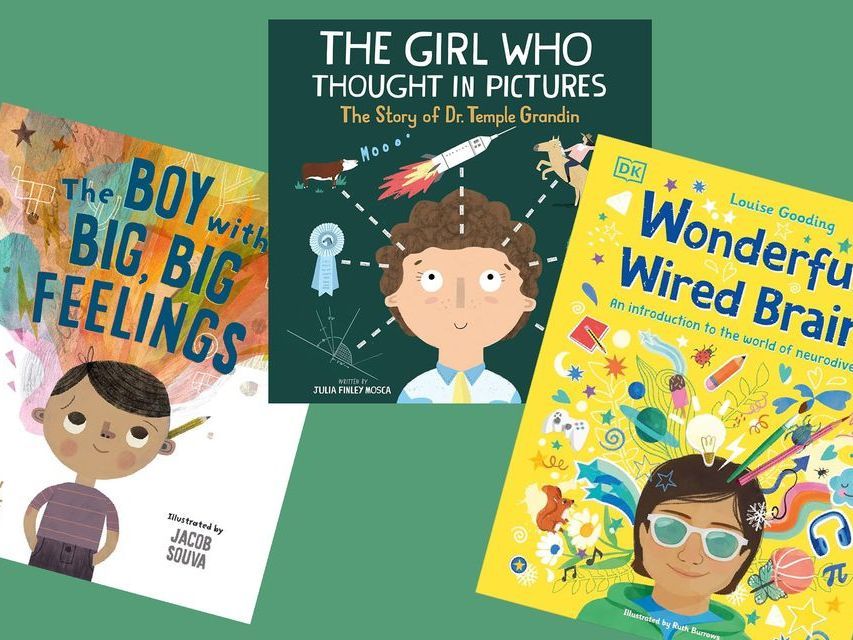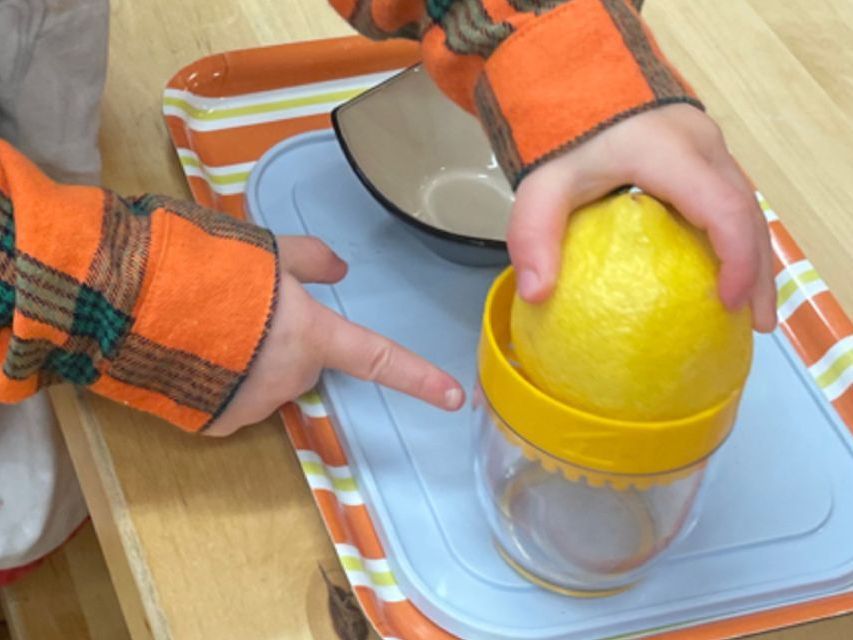Montessori Materials: The Stamp Game

This post is the first in a new series. Each month, throughout this school year, we will share information about a different Montessori material. Doing so will help parents who are curious about what goes on in our classrooms, but it will also give unique insight into Montessori principles and how the method was developed.
Today we talk about the stamp game. A beloved math material that is used by children sometime as early as about age five (depending upon their readiness) and up into elementary, it allows young children to add, subtract, multiply, and divide using numbers into the thousands. Using a material such as the stamp game allows children to learn a concept in concrete terms, rather than abstractly (which is what they will be doing when they eventually complete the same types of problems with just pencil and paper).
Think back to when you learned basic math computations: it was very likely done abstractly, and you memorized what must be done when your numbers added up to more than ten in one column, or you needed to borrow some from the next column, and so on. Being taught that way certainly gets the job done, but what we are effectively doing then is teaching children to memorize the process.
Using a material like the stamp game allows children to physically manipulate the numbers in a way that provides a deeper and richer understanding of mathematical processes. Instead of feeling tedious and confusing, the stamp game provides a stepping stone that helps children feel excited to discover the secrets of numbers and operations. Many Montessori children have reported that as they get older and find themselves working on much more complicated math concepts, they still picture the movement of the tiny stamps in their minds. They have a lasting visual image of what the numbers are doing as they work; it’s not just rote memorization.
Please bear in mind that prior to being introduced to this material, the child will have a solid understanding of place value, as well as the basic concept of each operation (addition, multiplication, division, and subtraction). These skills will have been gained through other Montessori materials that were carefully developed and intended to be used in a specific sequence.
So let’s get down to the important part: how the stamp game is used.
A child or small group of children will be seated on the floor across from their guide. A work mat will have been unrolled, and the guide will stand up, walk across the room, and carefully select the material from the shelf, carrying it carefully to the work mat. Even this small action has purpose: the guide is wordlessly teaching the child where the material can be found and where it is expected to be returned, as well as modeling how it should be carried around the room.
When the box is opened the guide may ask the children what they notice. They may comment on the colors of the wooden tiles: green, blue, and red. They will notice the small numbers printed on each tile: units, tens, hundreds, and thousands. They may even notice little pegs that they will use much later when they use the same material for division.
The first step is to learn how to make numbers using the stamp game. The guide will write a number such as 3,721. They will then demonstrate by taking one green unit stamp out of the box and lining it up neatly on the rug in front of the compartment it came from. This will be followed by two blue tens tiles, seven red hundreds tiles, and three green thousands tiles. (The color pattern begins to repeat because much later, using a different material with the same colors, the child will learn about number series and why we separate larger numbers with commas. The idea is being introduced indirectly long before it is expressively taught.)
Children will then take turns making numbers. If the concept takes some effort, this may be their work and their practice for several days or weeks. If they seem ready for more, the guide will move onto the next step.
When moving into addition work with the stamp game, the children will learn or review the terms addend and sum, and will make each addend, separated by a space or perhaps a pencil, on the work mat. The guide will then slide the bottom of each column of tiles upward, creating a single line for each place, as illustrated in the photo above. Starting at the bottom of the units, the tiles will be carefully counted and recorded in the proper place wherever the problem is written down. This will continue with the tens, hundreds, and thousands.
At first, the problems will have been carefully selected so that there is no need for exchanging. Once the child is ready for more of a challenge, they will learn that if there are ten unit tiles, they will need to be gathered up, deposited back into their compartment, and exchanged for one tens tile. They will learn to say aloud to themselves, “Ten units is equal to one ten,” and so on.
The lesson will end, and if the guide feels the children have grasped the concept well enough, they will be expected to use the material regularly and independently (or with a friend) to complete problems. The guide will periodically check in to observe and determine when mastery is achieved.
Whenever the child is ready (which could be weeks or even months), they will learn how to use the stamp game for other operations, such as subtraction. Again, the first problems will not involve any exchanging of numbers and will simply be a way to understand the basic process. You can begin to imagine the many steps and complexity of each Montessori material. When subtracting, the child will lay out the minuend, slide down the subtrahend, and find the difference.
With multiplication, children learn that all multiplication is making the same number a specific amount of times. They will see its connection to addition, as the process is very similar.
As for division, the guide will introduce tiny wooden cups - one for each place value. Children look at the dividend and put the correct amount of tiles into the cups. They will then use the wooden pegs mentioned earlier (called skittles as they resemble bowling pins), to mark the divisor. Rather than lining the tiles up beneath the compartments, they now learn to line them up beneath the skittles. They learn that division is about being fair, and that it is the only operation in which we start by using the largest quantity available rather than starting with the units.
It can take an entire year (or longer) for a child to move through each of the steps described. The guide will keep a close watch on each individual’s progress, and provide them with more challenge as soon as they are ready. When a child has fully exhausted their learning with the stamp game, they are ready to move on to a slightly more abstract math material: the bead frame.
We hope you enjoyed this article. Want to see the stamp game in action? We believe having parents observe in our classrooms is a critical component of our success. Contact us to schedule a tour and learn more.

Contact Us
© 2024 The Montessori School of the Berkshires
PO Box 422, 21 Patterson Road, Lenox Dale, MA 01242









